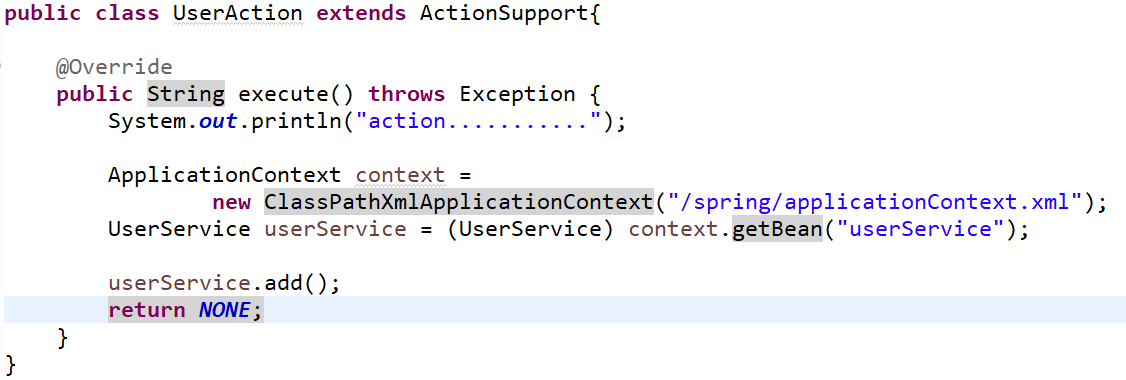引言:
在刚开始我们接触IOC时,我们加载并启用SpringIOC是通过如下代码手动加载 applicationContext.xml 文件,new出context对象,完成Bean的创建和属性的注入。
public class TestIOC {
@Test
public void testUser() {
// 1.加载Spring配置文件,创建对象
ApplicationContext context = new ClassPathXmlApplicationContext("/spring/applicationContext.xml");
// 2.得到配置创建的对象
Person person = (Person) context.getBean("person");
// 3.调用bean对象中的方法
person.test1();
}
}
注意:这只是测试代码,我们使用 Junit 进行单元测试,如果我们在实际生产过程中,每次创建对象都使用该代码加载配置文件,再创建对象。这种方法当然不可取,太浪费资源。其实,Spring早就帮我们解决了这个问题。
Spring和Web项目整合原理:
1、实现思想:
把加载配置文件和创建对象的过程,在服务器启动时完成。
2、实现原理:
(1)ServletContext对象
(2)监听器
3、具体使用:
(1)在服务器启动时候,会为每个项目创建一个ServletContext对象
(2)在ServletContext对象创建的时候,使用监听器(ServletContextListener)可以知道ServletContext对象在什么时候创建
(3)监听到ServletContext对象创建的时候,即在监听器的 contextInitialized()方法中加载Spring的配置文件,把配置文件配置对象创建
(4) 把创建出来的对象放到ServletContext域对象里面(setAttribute方法),获取对象的时候,从ServletContext域里得到(getAttribute方法)
Spring整合Web项目演示
1、演示问题(Struts2项目整合Spring时,不写监听,只通过代码加载Spring配置文件)
(1)action调用service,service调用dao

(2)每次访问 Action 的时候,都会重新加载Spring配置文件

2、解决方案:
(1)在服务器启动的时候,创建对象加载配置文件
(2)底层使用监听器、ServletContext对象
3、使用Spring框架,不需要我们写代码实现,帮我们进行了封装
(1)封装了一个监听器,我们只需要配置监听器就可以了
(2)配置监听器之前做的事:导入Spring整合 web 项目的 jar 包(Maven项目)
4、实际操作
(1)pom.xml中引入以下依赖:
<dependency>
<groupId>org.springframework</groupId>
<artifactId>spring-web</artifactId>
<version>4.0.2.RELEASE</version>
</dependency>
(2)web.xml中配置监听器:
<!-- 配置监听器 -->
<listener>
<listener-class>org.springframework.web.context.ContextLoaderListener</listener-class>
</listener>
(3)web.xml中指定加载Spring配置文件的位置
注意:如果我们不指定Spring配置文件的位置,容器会自动去 WEB-INF 目录下找 applicationContext.xml 作为默认配置文件。如果找不到,就会报如下错误。
![]()
<!-- 指定Spring配置文件的位置 -->
<context-param>
<param-name>contextConfigLocation</param-name>
<param-value>classpath:spring/applicationContext.xml</param-value>
</context-param>
控制台打印日志:
![]()